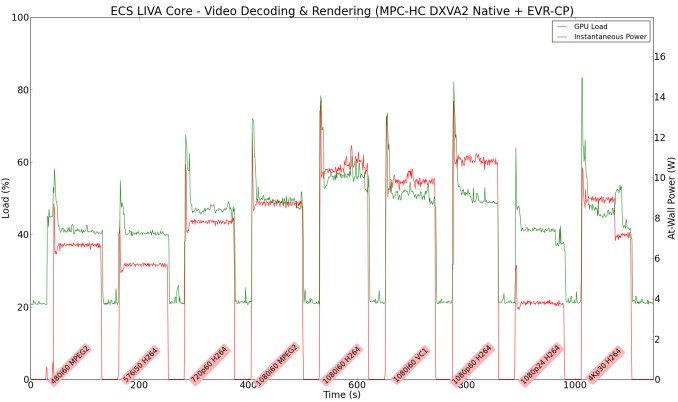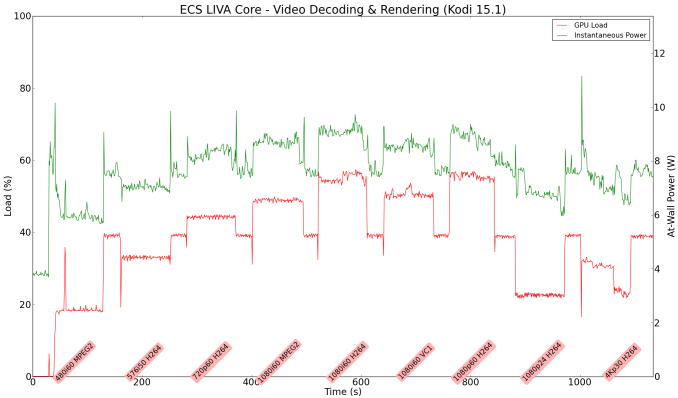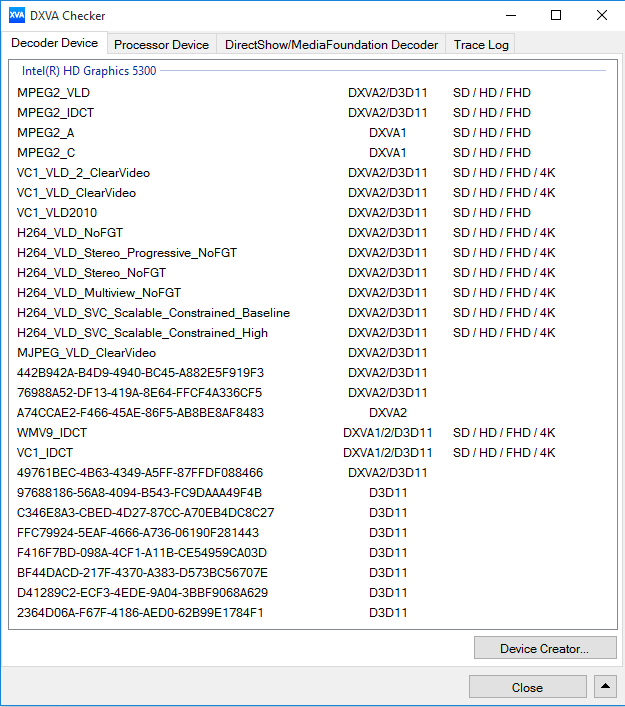ECS LIVA Core Review: A Fanless Core M mini-PC
by Ganesh T S on October 7, 2015 8:00 AM ESTHTPC Credentials
Given the ECS LIVA Core's fanless nature and the presence of Intel HD Graphics, we expect many purchasers to use it as a media playback machine / HTPC. It is obvious that we are not looking at a madVR capable machine, but one targeted at the entry-level / average HTPC user or someone looking for a HTPC to put in a second or third room (non-primary HTPC). There are two HTPC aspects that we will explore in this section, one related to network streaming (OTT services), and the other related to local file playback. Prior to that, we have a small sub-section dealing with refresh rate accuracy.
Refresh Rate Accurancy
Starting with Haswell, Intel, AMD and NVIDIA have been on par with respect to display refresh rate accuracy. The most important refresh rate for videophiles is obviously 23.976 Hz (the 23 Hz setting). As expected, the ECS LIVA Core has no trouble with refreshing the display appropriately in this setting.
The gallery below presents some of the other refresh rates that we tested out. The first statistic in madVR's OSD indicates the display refresh rate.
Network Streaming Efficiency
Evaluation of OTT playback efficiency was done by playing back our standard YouTube test stream and five minutes from our standard Netflix test title. Using HTML5, the YouTube stream now plays back a 1080p H.264 encoded stream. Since YouTube now defaults to HTML5 for video playback, we have stopped evaluating Adobe Flash acceleration. Note that only NVIDIA exposes GPU and VPU loads separately. Both Intel and AMD bundle the decoder load along with the GPU load. The following graph show the power consumption at the wall for playback of the HTML5 stream in Mozilla Firefox (v 41.0).

GPU load was around 47.56% for the YouTube HTML5 stream and 6.67% for the steady state 6 Mbps Netflix streaming case.
Netflix streaming evaluation was done using the Windows 8.1 Netflix app. Manual stream selection is available (Ctrl-Alt-Shift-S) and debug information / statistics can also be viewed (Ctrl-Alt-Shift-D). Statistics collected for the YouTube streaming experiment were also collected here.

Decoding and Rendering Benchmarks
In order to evaluate local file playback, we concentrate on EVR-CP and Kodi. We already know that EVR works quite well even with the Intel IGP for our test streams. EVR-CP was used in conjunction with the LAV Filters bundled with MPC-HC v1.7.9. Settings were left at default (except for 4K decoding to be hardware accelerated).
In our earlier reviews, we focused on presenting the GPU loading and power consumption at the wall in a table (with problematic streams in bold). Starting with the Broadwell NUC review, we decided to represent the GPU load and power consumption in a graph with dual Y-axes. Nine different test streams of 90 seconds each were played back with a gap of 30 seconds between each of them. The characteristics of each stream are annotated at the bottom of the graph. Note that the GPU usage is graphed in red and needs to be considered against the left axis, while the at-wall power consumption is graphed in green and needs to be considered against the right axis.
Frame drops are evident whenever the GPU load consistently stays above the 85 - 90% mark. All our test streams managed to play back without issues in the two configurations that were tested out.
Moving on to the codec support, the Intel HD Graphics 5300 is a known quantity with respect to the scope of supported hardware accelerated codecs. DXVA Checker serves as a confirmation.
The only unfortunate aspect here is the complete absence of any sort of hardware acceleration for HEVC. Even GPU-aided hybrid decode acceleration for HEVC Main profile (8b) is not available. Other codecs work flawlessly, as evident from our decoding and rendering benchmarks. On the audio side, we had no trouble getting HD audio bitstreaming to work.



















35 Comments
View All Comments
Pissedoffyouth - Wednesday, October 7, 2015 - link
What's the Linux support like? I'd want one to use as a main desktop PCJaybus - Wednesday, October 7, 2015 - link
The relatively new AC 3165 WLAN chip is supported in kernels 4.1+. With older kernels an Intel driver will be needed. I'm not sure of the exact minimum kernel version that the Intel driver supports. All of the other hardware should be supported in recent distros.WJames65 - Wednesday, October 7, 2015 - link
Nice to see Anandtech providing small footprint "mini PC" reviews. I just ordered a MSI cube with a Broadwell CPU. To the user who noted no H.265 support, Intel added driver support to Haswell and Broadwell months ago. The author of this review didn't mention H.265 support, and did not test it. Perhaps, another review or an update will include H.265 testing.ganeshts - Wednesday, October 7, 2015 - link
Please note the final paragraph in the HTPC Aspects section. HEVC decode (even hybrid acceleration) is NOT supported in the Broadwell Core M SKUs.WJames65 - Wednesday, October 7, 2015 - link
Yeah, I see that line in the HTPC section. However, Intel says otherwise: http://techreport.com/news/27677/new-intel-igp-dri...WJames65 - Wednesday, October 7, 2015 - link
This is interesting... According to Intel, only those CPUs with Iris 5500 or later have hardware accelerated H.265. Glad my mini-PC has such a GPU. :) See here: https://communities.intel.com/thread/59216Bob Todd - Wednesday, October 7, 2015 - link
I replaced a much larger HTPC with one of the cheap and tiny ECS LIVA units (dual core Bay Trail-M, gigabit ethernet, HDMI, 2GB RAM, 32GB emmc). For $99 it has proven to be a great little streamer for the modest needs in our bedroom. Low tdp. No fan . No blinding blue LEDs to disconnect.Einy0 - Wednesday, October 7, 2015 - link
I've been using the same unit in my living room for about a year now. The latest release of Windows 10 insider has nearly broken the Netflix app completely. I may have to move on to another platform or go back to Windows 8.1.Pissedoffyouth - Wednesday, October 7, 2015 - link
And what did we learn today about using alpha software?Gigaplex - Thursday, October 8, 2015 - link
Windows 10 insider program is not alpha. It's more like a cross between beta and release candidate.